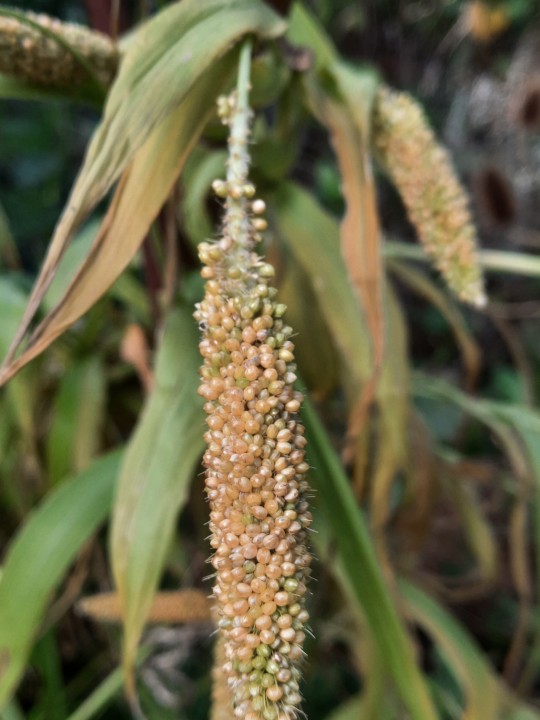#animals pesticides
Text
UC Riverside scientists have discovered a tiny worm species that infects and kills insects. These worms, called nematodes, could control crop pests in warm, humid places where other beneficial nematodes are currently unable to thrive.
This new species is a member of a family of nematodes called Steinernema that have long been used in agriculture to control insect parasites without pesticides. Steinernema are not harmful to humans or other mammals and were first discovered in the 1920s.
Continue Reading.
231 notes
·
View notes
Text
#vegetarian#organic#eating healthy#it’s really hard#what DOESN’T have pesticides#I just don’t want to contribute to the suffering of animals#but sometimes I need bbq
21 notes
·
View notes
Text
#good news#science#environmentalism#nature#environment#animals#climate change#conservation#bugs#pesticides#insects#insecticides
37 notes
·
View notes
Text



I grew some millet in my allotment garden this year despite the climate really not being that suited for it. I didn't use pesticides or otherwise protect the plants either so I didn't expect much of it, but the plants survived and the wildlife left enough for Vaiya to enjoy. I hope the wild little birds enjoyed it too. :')
#supposedly millet is healthier this way because food grown for animals 1. is often stored too long 2. and higher % of pesticides on it#parrots#birds#lineolated parakeet#linnie#gardening
25 notes
·
View notes
Text
The federal Animal and Plant Health Inspection Service is proposing to spray toxic insecticides within treasured and significant landscapes of the Colorado Plateau in northern Arizona to kill native grasshoppers.
The areas being considered include portions of the Vermilion Cliffs National Monument, Grand Canyon-Parashant National Monument, and the newly designated Baaj Nwaavjo I’tah Kukveni – Ancestral Footprints of the Grand Canyon National Monument.
“This is a dangerous plan that could kill creatures that are key to northern Arizona’s unique biodiversity, which these national monuments were designated to protect,” said Taylor McKinnon, Southwest director at the Center for Biological Diversity. “The federal government needs to stop downplaying the extinction crisis and back off its reckless plan to smother biodiversity hotspots with toxic pesticides.”
One out of every 10 plant species in the Colorado Plateau region is found nowhere else on Earth.
The agency's draft environmental assessment omits mention of the national monuments and unique species and habitats they were designated to protect. These species include rare bees, butterflies and other creatures found nowhere else, like the Kaibab monkey grasshopper and House Rock Valley chisel-toothed kangaroo rat, specifically named in the August proclamation establishing the Baaj Nwaavjo I’tah Kukveni National Monument.
APHIS oversees and funds the application of multiple pesticides on rangelands to prevent native grasshoppers and Mormon crickets from competing with livestock for forage.
The proposed insecticides — carbaryl, diflubenzuron and chlorantraniliprole — are indiscriminate. In addition to the grasshoppers the agency is targeting, the insecticides can also kill bees, moths and other insects. Spraying can harm entire ecosystems by disrupting pollination and can harm populations of birds, reptiles and mammals who feed on grasshoppers and insects.
Although grasshoppers and Mormon crickets can be locally abundant from time to time, native plants and other wildlife evolved with these cycles. Introducing pesticides to eliminate native grasshoppers is a shortsighted, quick fix that fails to consider the complex interrelationships within these delicate ecosystems.
The agency’s draft analysis shows that it has failed to consult with affected Tribes with ties to the Grand Canyon area. The Grand Canyon Tribal Coalition, which proposed the Baaj Nwaavjo I’tah Kukveni National Monument, includes members of the Havasupai Tribe, Hopi Tribe, Hualapai Tribe, Kaibab Band of Paiute Indians, Las Vegas Tribe of Paiutes, Moapa Band of Paiute Indians, Paiute Indian Tribe of Utah, Shivwits Band of Paiutes, Navajo Nation, San Juan Southern Paiute Tribe, Yavapai-Apache Nation, Zuni Tribe and Colorado River Indian Tribes.
“It’s so important that APHIS honor the promise made to work together with Tribal nations to protect the sacred spaces and resources within the Baaj Nwaavjo I’tah Kukveni Monument when it was established less than six months ago,” said Sharon Selvaggio, pesticide program specialist with The Xerces Society for Invertebrate Conservation. “We call on the agency to protect natural systems on Tribal and public lands by employing nonchemical management that allows humans and wildlife to thrive.”
In March 2023 the U.S. Environmental Protection Agency published a draft biological opinion from NOAA Fisheries showing that carbaryl is likely to jeopardize 37 species protected under the Endangered Species Act, and harm 36 designated critical habitats.
While Arizona is not home to any of the species named in that report, the findings show the extreme harm carbaryl poses to endangered fish and other species.
The U.S. Fish and Wildlife Service, which is charged with protecting endangered plants and animals, has not yet completed a proper analysis of the potential harms from the APHIS proposal. Potentially vulnerable endangered species in Arizona include Chiricahua leopard frogs, western yellow-billed cuckoos, Gila chub, black-footed ferrets and Siler pincushion cacti.
APHIS is accepting comments on the proposal until 4 p.m. MST on Feb. 2.
#ecology#enviromentalism#pesticides#Baaj Nwaavjo I'tah Kukveni Monument#grand canyon#Grand Canyon national monument#Vermillion Cliffs National Monument#arizona#colorado plateau#Animal and Plant Health Inspection Service#APHIS#epa#fish and wildlife#wildlife services#Fuck Wildlife Services#insecticide#endangered species act#endangered species
4 notes
·
View notes
Text
i forgot to tell you guys abt marcus’s stupid powers /aff
#shapeshifter. so. whatever he turns into is animal based. and derive from mostly emotions#they’re uncomfortable for the most part#scott HAS fought him and the rest of his band#pesticide …. is the name of their band#just for fun#they fought for fun#“who won??” ………………… i don’t know yet#pom’s… words.#pepper’s ocs#UNCOMFORTABLE??? UNCONTROLLABLE ******
2 notes
·
View notes
Link
Around 1 billion pounds of conventional pesticides are sprayed and scattered each year in the United States, applied to everything from the food we eat, to the grass we walk on, to the plants in our gardens. Although invisible, many of these chemicals remain in soil and water for months or years, killing far more than just the garden pests we hope to eliminate...
#birds#bird#birdwatching#ornithology#insects#insect#entomology#animals#nature#pesticides#pollustion#conservation#environment#gardens#gardening
67 notes
·
View notes
Text
i find it horrendously hilarious how everyone in my neighborhood complains there's no bees, no birds, the wildlife is disappearing....but they're all cutting their wild flowers, letting their cats out, their dogs run rampant, fencing the animals out, etc.
meanwhile any time I walk outside I'm likely to trip around turkeys, get a deer's wet nose on my rear, forced to tiptoe around a multitude of bee species and other pollinators, fledgling birds almost landing on me, the works.
they all just like it here better than there, where the grass is green and everything blooms
#there used to be herds of 40+ deer but now there's small clans of only 4 at best before all their buddies slaughtered them!!!#maybe if some of these idiots stopped spraying pesticides and cutting the weeds the bees would visit#literally just put out some water for them or something cripes#and control yalls animals the wildlife's not being a nuisance you're in their path buncha stupid city folks movin out here#i'm just grumbling
16 notes
·
View notes
Text
🤮🤮🤮
#save lives#warning#must know#know what you eat#pesticides#hormones#antibiotics#poisson#danger#puss#animal flesh#human flesh#deadly#GMO kills#animal fat#toxic#cancerous#health#cholesterol#blood#chemicals#unhealthy#truth wins#please share#wwg1wga
21 notes
·
View notes
Text
Just read the weirdest thread on my suggestions,
A.V. : Oh so now Cattle is a danger to the planet? Well riddle me THIS "VEGUNS" (they mean like, the U.N. but whatever), Replace All those grazing livestock with a Soy Field Monocrop and what will you have?? 40 years from now, it'll be the same if not W0rse! You want Pesticide drenched, Toxic sludged, Water Draining, Small Rodent killing harvesting PLANT FARMS is that what you want?!
Me: ....im hopin for a hydroponic farm in a gutted out building near the grocery store?

#we...are already starting to use them and they require#90% less water and nutrients#they grow faster and it has no impact on flavor?#And it's in a sterilized building so no need to worry about pesticide use or animals?? being chopped up?? Via the “harvest” process?#Im sure since we already have it now it'll... be improved in 40 years?#veganism#vegan#antivegan nonsense#hell i even have a hydroponic garden in my house and lemme tell you#way easier than the raised beds outside and tastier produce too i want that for everyone?#I also bought some hydroponic lettuce from Giant that was grown a couple miles from my house#can we dream of a better world
10 notes
·
View notes
Text
I was wondering why I don't see a lot of fireflies anymore. I thought it was just nostalgia for a time when all I had to do was play with lego sets and have lightsaber fights in my backyard.
then I went to google and found this.
I'm already dealing with dumbass conservative state senators.
why this?
#fireflies#pollution#light pollution#pesticides#save fireflies#sad#nostolgia#childhood#end of childhood#capitalists killed the fireflies#planet earth#animal kingdom
4 notes
·
View notes
Text
#good news#pesticides#natural pesticides#pest control#environmentalism#science#environment#nature#animals#roses#rose essential oil#organic#agriculture
10 notes
·
View notes
Text
Guess who just got kicked out of a gardening group on Facebook for saying that killing wildlife indiscriminately is wrong and counterproductive to having a garden

#gardening#animal cruelty#Facebook hell#goblin posting#pesticides kill everything#if you’re a good gardener your plants don’t kill what eats them#ecology#work with nature not against it#responsible gardening#environmentalism#silent spring
2 notes
·
View notes
Text
@allvalley100
Prompt: The Grass is Greener
Pairing: YasMoon
***
“I love your garden.”
Yasmine brushes her fingers across California poppies and hummingbird sage. Her suburban parents would turn their noses up at this place—understated flower bushes and scratchy shrubs divided by tan and gray stones. Unconventional.
She curls her lip. “My mom’s so proud of our lawn. Says it’s the greenest, tidiest one in the neighborhood. I think it’s boring as shit.”
Arms wrap her from behind, and she feels Moon’s nose in her hair. “When we get our own place, we can plant whatever flowers you want.”
Yasmine laces her fingers with Moon’s, smiling. “I’d like that.”
#allvalley100#yasmoon#yasmine x moon#moon x yasmine#yasmine cobra kai#moon cobra kai#cobra kai#cobra kai season 1#cobra kai season 3#cobra kai season 4#just gonna tag all the seasons where they're being sapphic#which is most of them#but this could take place whenever#I am very very attached to the headcanon that Moon is very into like...girly but sustainable stuff lmao#I just think she loves sustainable gardening and sustainable fashion and puts cutesy 'save the [insert very fluffy endangered animal]!!!#on her laptop#I love to think she and her family planted a full ass native plant garden while Yasmine's stuck with a super uniform lawn#loaded with pesticides and weed killers and shit#poor Yas
14 notes
·
View notes
Text
Remember kids!
The concept of science may be neutral, but scientists are not!
Everyone has a political agenda, especially when we live under capitalism and people have to get money to do all the stuff they do!
Yes, even if they agree with you!!!!
#this is about PBS' scishow and ecetera shows all constantly doing the whole oooooooooooooooooh we MUSTTTTTTTTTTttt grow food in labs to#FEEEEEEEEEEd everyone!!!!!!!!!!!!!!!!!!!!!!!!!!!!!!!!!!#ignoring the fact that shit tons of literally perfectly good food is thrown away#LITERALLY FOR NO REASON EXCEPT IT'S NOT PROFITABLE ENOUGH#we do not need to grow steak in labs or have skyscrapers filled with lettuce.#we need to overthrow capitalism and stop throwing food away rather than give it to people#we need to stop fucking arresting people for dumpster diving#we need to stop criminalizing existing as a poor person#we need to overhaul animal welfare and fucking give indiginous people sovereign rights over the land#we need to stop fucking just killing the soil by overfarming monocultures#and killing insects with pesticides sprayed from fucking helicopters#the solution to world hunger is not make more food.#there's enough food.#you just have to start caring about feeding people more than you do making money#a goal which will never see fruition YES PUN INTENDED under capitalism
4 notes
·
View notes
Text
you know when biologists generally would go into jungles and shoot birds and stuff like that to serve as specimens. it feels like that to me like nobody does that anymore w vertebrates unless its necessary for some reason i feel like invertebrates just arent treated as living things in the same way
#and i know that back then shooting them was the most practical means for them just like sometimes killing and collecting bugs is#the most practical method now as well. and can be more ethical than the alternatives#and theres people who love insects and care for them even if they do sometimes need to also euthanize them and thats fine w me too#but theres plenty of people who literally just dont care or think of them as animals capable of experiencing any kind of suffering#people going into the field specifically to kill them. once again i know it can be imprtant. i just dont think it can be me#half the semester's units are about pesticides
5 notes
·
View notes